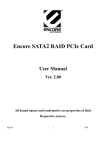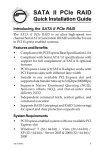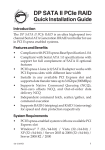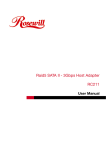Download Addonics Technologies ADSA3GPX1-2E User`s guide
Transcript
Addonics T E C H N O L O G I E S 2-Port eSATA II RAID5/JBOD PCI Express Controller Card (ADSA3GPX1-2E) User’s Guide Revision 1.1 FCC Warning Statement This equipment has been tested and found to comply with the limits for a Class B digital device pursuant to Part 15 of the FCC rules. These limits are designed to provide reasonable protection against harmful interference in a residential installation. This equipment generates, uses and can radiate radio frequency energy. If not installed and used in accordance with the instructions, it may cause harmful interference to radio communications. However, there is no guarantee that interference will not occur in a particular installation. If the equipment does cause harmful interference to radio or television reception, which can be determined by turning the equipment on and off, the user is encouraged to try and correct the interference by one or more of the following suggestions. Reorient or relocate the receiving antenna Increase the distance between the equipment and the receiver Connect the equipment to a different power outlet other than the one where receiver is connected Consult a certified television or radio technician LIMITED WARRANTY Addonics guarantees that every product is free from physical defects in material and workmanship during the warranty period specified for each product when used within the limits set forth in the Specifications section in the user guide. Unauthorized temperin g of the product or using it outside the scope of the product specifications will result in voiding the warranty. If the product proves defective during this warranty period, call Addonics Technical Support to obtain a Return Authorization number. BE SURE TO HAVE YOUR PROOF OF PURCHASE ON HAND WHEN CALLING. RETURN REQUESTS CANNOT BE PROCESSED WITHOUT PROOF OF PURCHASE. When returning a product, mark the Return Authorization number clearly on the outside of the package and include your original proof of purchase. Customers are responsible for paying the shipping and handling of the products to Addonics warranty service location. IN NO EVENT SHALL ADDONICS’ LIABILITY EXCEED THE PRICE PAID FOR THE PRODUCT FROM DIRECT, INDIRECT, SPECIAL, INCIDENTAL, OR CONSEQUENTIAL DAMAGES RESULTING FROM THE USE OF THE PRODUCT, ITS ACCOMPANYING SOFTWARE, OR ITS DOCUMENTATION. Addonics makes no warranty or representation, expressed, implied, or statuary, with respect to its products or the contents or use of the user guide and all accompanying software, and specifically disclaims its quality, performance, merchantability, or fitness for any particular purpose. Addonics reserves the right to revise or update its products, software, or documentation without obligation to notify any individual or entity. Addonics Technologies Users Guide v1.0 2-Port e SATA II RAID5/JBOD PCI Express Controller Card 1 Contents FCC Warning................................................................................... 1 LIMITED WARRANTY ................................................................. 1 Contents............................................................................................ 2 Chapter 1 Specifications ................................................................... 3 Chapter 2 RAID Tutorial .................................................................. 4 Chapter 3 BIOS Installation .......................................................... 5-6 Chapter 4 New Windows System (fresh installation)...................... 7-9 Chapter 5 Existing Windows System installation ....................... 10-16 Hardware Configuration ............................................ 10-11 Windows 2000 Driver ............................................... 11-12 Windows XP Driver .................................................. 13-14 Windows 2003 Server .............................................. 15-16 Verifying controller driver.............................................. 16 Technical Support & Contact Information .................................... …17 Addonics Technologies Users Guide v1.0 2-Port e SATA II RAID5/JBOD PCI Express Controller Card 2 Chapter 1 Specifications General = Integrated Serial ATA Transport, Link and PHY logic = Compliant with Serial ATA 1.0a specification with support for full complement of SATA II optional features = Supports 2 nd –generation Serial ATA II transfer rate of 3.0Gbps = Signal output amplitude control for External SATA = Supports two independent Serial ATA channels • Independent Link, Transport and data FIFO • Independent command fetch, scatter/gather and command execution • Supports Native Command Queuing and Tagged Command Queuing • Supports First-Party DMA • Supports port multipliers with FIS-based switching under hardware control = 31 commands and scatter/gather tables per port on-chip = Protocol override per command = Silicon Image chipset SiI 3132 PCI-X Interface =Supports one-lane, 2.5 Gbps =Compliant with PCI Express 1.0a specification =All registers appear in unified memory space =All registers accessible through I/O space =Full-chip command-completion status accessible with single PCI Express access Addonics Technologies Users Guide v1.0 2-Port e SATA II RAID5/JBOD PCI Express Controller Card 3 Chapter 2 RAID tutorial 2. What is RAID? RAID - Redundant Array of Independent Disks RAID technology manages multiple disk drives to enhance I/O performance and provide redundancy in order to withstand the failure of any individual member, without loss of data. This card provides two RAID Set types, Striped (RAID 0) and Mirrored (RAID 1). 2.1 Disk Striping (RAID 0) Striping is a performance-oriented, non-redundant data mapping technique. While Striping is discussed as a RAID Set type, it is actually does not provide fault tolerance. With modern SATA bus mastering technology, multiple I/O operations can be done in parallel, enhancing performance. Striping arrays use multiple disks to form a larger virtual disk. 2.2 Disk Mirroring (RAID 1) Disk mirroring creates an identical twin for a selected disk by having the data simultaneously written to two disks. This redundancy provides instantaneous protection from a single disk failure. If a read failure occurs on one drive, the system reads the data from the other drive. 2.3 Mirrored-Striping (RAID 1+0) A Mirrored-Striping Set does just what it says, combining both Striping and Mirroring technologies to provide both the performance enhancements that come from Striping and the data availability and integrity that comes from Mirroring. When data is written to a Mirrored-Striped Set, instead of creating just one virtual disk, as Striping would do, a second, mirrored virtual disk is created as well. 2.4 Parity RAID (RAID 5) Parity or RAID 5 adds fault tolerance to Disk Striping by including parity information with the data. Parity RAID dedicates the equivalent of one disk for storing parity stripes. The data and parity information is arranged on the disk array so that the parity is written to different disk. There are at least 3 members to a Parity RAID set. 2.5 JBOD (Just Bunch of Disks) The JBOD is a virtual disk that can either be an entir e disk drive or a segment of a single disk drive. Addonics Technologies Users Guide v1.0 2-Port e SATA II RAID5/JBOD PCI Express Controller Card 4 Chapter 3 BIOS Installation (RAID Setting) Creating and deleting RAID sets is a function found in the BIOS. During boot up, the RAID setting message will appear and pause for a few moments to allow the user to choose what to do. This board will act as normal NON-RAID card when BIOS not configured for RAID. Just proceed to Software Installation section directly. If you use traditional parallel ATA HDD, make sure your hard drives be set up as master mode before the RAID setting. 3.1 Creating Striped Sets (RAID 0) 1. As the BIOS boots, Press CTRL+S or F4 to enter the raid bios utility. 2. Select Create RAID set. Press Enter. 3. Select Stripe then press Enter. 4. Select Auto configuration or manually select the drives Press Enter. 5. Press Y to save your settings. 6. Press CTRL+E and then press Y to exit the setup. 7. Your RAID configuration is complete. Please proceed to software installation section. 3.2 Creating Mirrored Sets (RAID 1) 1. As the BIOS boots, Press CTRL+S or F4 to enter the raid bios utility. 2. Select Create RAID set. Press Enter. 3. Select Mirrored then press Enter. 4. Select Auto configuration or manually select the drives. Press Enter. 5. Press Y to save your settings. 6. Press CTRL+E and then press Y to exit the setup. 7. Your RAID configuration is complete. Please proceed to software installation section. 3.3 Creating a Mirrored-Striped Set (RAID 1+0) 1. As the BIOS boots, press CTRL+S or F4 to enter the raid bios utility. 2. Select Create RAID set. Press Enter. 3. Select RAID 1 set then press Enter. 4. Select Auto configuration or manually select the drives. Press Enter. 5. After the Raid 1 set is created then click on Create Raid Set again. 6. Press Create the spare drive. Select the drive to be the spare. 7. Press Y to save your settings. 8. Press Ctrl-E then Y to exit the setup. 9. Your RAID configuration is complete. Please proceed to software installation section. Addonics Technologies Users Guide v1.0 2-Port e SATA II RAID5/JBOD PCI Express Controller Card 5 3.4 Creating a Spare Drive 1. As the BIOS boots, press CTRL+S or F4 to enter the raid bios utility. 2. Select Create RAID set. Press Enter. 3. Select RAID 1 set then press Enter. 4. Select Auto configuration or manually select the drives. Press Enter. 5. After the Raid 1 set is created then click on Create Raid Set again. 6. Press Create the spare drive. Select the drive to be the spare. 7. Press Y to save your settings. 8. Press Ctrl-E then Y to exit the setup. 9. Your RAID configuration is complete. Please proceed to software installation section. Note: Raid 1 must be created first before spare drive can be created. 3.5 Deleting RAID Sets 1. As the BIOS boots, Press CTRL+S or F4 to enter the raid bios utility. 2. Select Delete RAID set. Press Enter. 3. Answer Y to remove the RAID set. If the RAID set being deleted is a Striped set, then all of the data will be lost. If the set being deleted is a Mirrored set, then the data will remain intact and accessible on both drives. 3.6 Rebuilding Mirrored Sets 1. After replacing the failed hard drives boot the BIOS, Press CTRL+S or F4 to enter the raid bios utility. 2. Select rebuilding Mirrored set. Press Enter. 3. Select Online rebuild or Offline rebuild. 4. Answer Y to rebuild the Mirrored set of hard drive. 3.7 Resolving Conflict When a RAID set is created, the metadata written to the disk includes drive connection information (Primary and Secondary). If, after a disk failure, the replacement disk was previously part of a RAID set (or used in another system), it may have conflictin g metada ta, specifically in reference to the dr ive connection information. If so, this will prohi bit the RAID set from being either created or rebuilt, In order for the RAID set to function properly, this old metadata must be first overwritten with the new metadata. To resolve this, select Resolve Conflicts, and the correct metadata, including the correct drive connection information; will be written to the replacement disk. Addonics Technologies Users Guide v1.0 2-Port e SATA II RAID5/JBOD PCI Express Controller Card 6 Chapter 4 New Windows XP Systems (Fresh Installation) Before installation, extract the driver files to a floppy diskette. a. Open the Addonics Technologies Driver Disk. b. Windows Explorer will open up with two folders. Drivers Utilities c. Various drivers are available under the folder Drivers. Depending on the operating system that you are using extract the driver onto Drive A (Floppy Drive). Hardware Installations: 1. Remove PC cover. 2. Select an empty PCI Express slot and insert the SATA Controller. 3. Makes sure to secure the bracket with a screw. 4. Close the PC’s cover. Hardware Configuration Port 1 Note: To do a fresh install of Windows, your hard drive must be connected to Port 1 of the host controller. Fresh Windows Operating System Installation Types: A. Concatenated Raid Set Requires One hard drive B. Stripped Raid Set (RAID 0) Requires Two hard drives C. Mirrored Raid Set (RAID 1) Requires Two hard drives Addonics Technologies Users Guide v1.0 2-Port e SATA II RAID5/JBOD PCI Express Controller Card 7 Note: You cannot create a RAID 5 Set for a Fresh Windows Operating System Installation. A. CONCATENATED RAID Set Configuration in RAID BIOS: 1. Power ON your PC. 2. Wait until the system prompts for the RAID BIOS Configuration Utility. Press CTRL+ S or the F4 key to enter the BIOS RAID Utility. 3. The RAID Utility menu screen will be displayed. Select Create RAID set. 4. Choose CONCATENATION. Press Enter. Press Enter to select first drive of the RAID set. 5. Are You Sure? Press Y. 6. Under the Logical Drive Component, you should see SiI Concatenation and the Drive Capacity. 7. Press CRTL+E to Exit. 8. Are you sure to exit? Press Y. 9. The PC will reboot. 10. At the Windows Set-up screen, press F6 to specify and add the driver. 11. Insert the Floppy Driver diskette containing the driver from step 1 above. Press S, then press Enter. 12. Select Silicon Image SiI 3132 SoftRAID 5 Controller for Windows XP/ Server 2003 or Silicon Image SiI 3132 SoftRAID 5 Controller for Windows 2000, press Enter. 13. Press Enter to continue and follow on-screen instructions to complete installation. B. STRIPPED RAID Set Configuration in RAID BIOS: 1. Power ON your PC. 2. Wait until the system prompts for the RAID BIOS Configuration Utility. Press CTRL+ S or the F4 key to enter the BIOS RAID Utility. 3. The RAID Utility menu screen will be displayed. Select Create RAID set. 4. Choose RAID 0. Press Enter. Press Enter to automatically create RAID set. 5. Press Enter to select the Raid size. 6. Are You Sure? Press Y. 7. Under the Logical Drive Component, you should see SiI Raid0 Set and the Drive Capacity. 8. Press CRTL+E to Exit. 9. Are you sure to exit? Press Y. 10. The PC will reboot. 11. At the Windows Set-up screen, press F6 to specify and add the driver. 12. Insert the Floppy Driver diskette containing the driver from step 1 above. Press S, then press Enter. Addonics Technologies Users Guide v1.0 8 2-Port e SATA II RAID5/JBOD PCI Express Controller Card 13. Select Silicon Image SiI 3132 SoftRAID 5 Controller for Windows XP/ Server 2003 or Silicon Image SiI 3132 SoftRAID 5 Controller for Windows 2000, press Enter. 14. Press Enter to continue and follow on-screen instructions to complete installation. C. MIRRORED RAID Set Configuration in RAID BIOS: 1. Power ON your PC. 2. Wait until the system prompts for the RAID BIOS Configuration Utility. Press CTRL+ S or the F4 key to enter the BIOS RAID Utility. 3. The RAID Utility menu screen will be displayed. Select Create RAID set. 4. Choose RAID 1. Press Enter. Press Enter to automatically create a RAID 1 set without data copy. 5. Press Enter to select the Raid size. 6. Are You Sure? Press Y. 7. Under the Logical Drive Component, you should see SiI Raid1 Set and the Drive Capacity. 8. Press CRTL+E to Exit. 9. Are you sure to exit? Press Y. 10. The PC will reboot. 11. At the Windows Set-up screen, press F6 to specify and add the driver. 12. Insert the Floppy Driver diskette containing the driver from step 1 above. Press S, then press Enter. 13. Select Silicon Image SiI 3132 SoftRAID 5 Controller for Windows XP/ Server 2003 or Silicon Image SiI 3132 SoftRAID 5 Controller for Windows 2000, press Enter. 14. Press Enter to continue and follow on-screen instructions to complete installation. Addonics Technologies Users Guide v1.0 2-Port e SATA II RAID5/JBOD PCI Express Controller Card 9 Chapter 5 Existing Windows System installation Existing System with Port Multiplier Hardware Configuration Port 1 Port 1 Note: Using the Port Multiplier with the ADSA3GPX1-2E host controller In the RAID BIOS, you can only see ONE hard drive, even if the all 5 hard drives are connected to the Port Multiplier’s five ports. The hard drive that you see is the one connected to port 1 of the Port Multiplier where the Port Multiplier is connected to port 1 of the host controller. Addonics Technologies Users Guide v1.0 2-Port e SATA II RAID5/JBOD PCI Express Controller Card 10 This section provides the information on how to install the drivers of RAID Native SATA-150 4Ports PCI Host Adapter onto computer with existing operating systems: 5.1. Windows 2000 Driver and software installation For Existing Windows 2000 Systems (with Service Pack 2 or later) Note: Install the SATA Utilities from the CD that came with your package first before installing the Host Controller. 1. 2. 3. 4. 5. Power on the system. Insert the CDROM that came with the product. The Addonics Technologies Driver Disk window pops up. Windows Explorer will open up with two folders. Drivers Utilities Select the Utilities folder. Under this folder you will find three folders. These folders are: Install first-Java JRE Windows 32 bits Java RAID GUI Windows 64 bits Java RAID GUI Double click the Install first-Java JRE folder. Install the Java Runtime Environment Software by clicking the j2re-1_4_2-windows-i586iftw.exe. Follow the instructions. Double click the Windows 32 bits Java RAID GUI folder. Install the SATARAID5 software by clicking 3132_x86_win32_SATARAID5_1020. a. Welcome to the InstallShield Wizard for 3132 SATARAID5. Click Next. a. InstallShield Wizard: Choose Destination Location. Click Next. b. InstallShield Wizard: Select Components. Click Next. c. InstallShield Wizard: Start Copying Files. Click Next. d. Do you want to create a desktop icon? Click either Yes or No. e. InstallShield Wizard: InstallShield Wizard Complete. Click Finish. Hardware Installations: 6. Power OFF PC and remove its cover. 7. Select an empty PCI Express slot and insert the SATA Controller. 8. Makes sure to secure the bracket with a screw. 9. Close the PC’s cover. Addonics Technologies Users Guide v1.0 2-Port e SATA II RAID5/JBOD PCI Express Controller Card 11 Windows 2000 Driver Installations 10. Turn computer ON. When Windows boots up, “Found New Hardware Wizard” pops on the screen. 11. Please wait while the wizard installs the software… 12. When the new hardware wizard has finished installing the device and it’s component, restart the PC for the new settings to take effect. Addonics Technologies Users Guide v1.0 2-Port e SATA II RAID5/JBOD PCI Express Controller Card 12 5.2. Windows XP Driver and Software Installation Note: Install the SATA Utilities from the CD that came with your package first before installing the Host Controller. 1. 2. 3. 4. 5. Power on the system. Insert the CDROM that came with the product. The Addonics Technologies Driver Disk window pops up. Windows Explorer will open up with two folders. Drivers Utilities Select the Utilities folder. Under this folder you will find three folders. These folders are: Install first-Java JRE Windows 32 bits Java RAID GUI Windows 64 bits Java RAID GUI Double click the Install first-Java JRE folder. Install the Java Runtime Environment Software by clicking the j2re-1_4_2-windows-i586iftw.exe. Follow the instructions. Double click the Windows 32 bits Java RAID GUI folder. Install the SATARAID5 software by clicking 3132_x86_win32_SATARAID5_1020. a. Welcome to the InstallShield Wizard for 3132 SATARAID5. Click Next. b. InstallShield Wizard: Choose Destination Location. Click Next. c. InstallShield Wizard: Select Components. Click Next. d. InstallShield Wizard: Start Copying Files. Click Next. e. Do you want to create a desktop icon? Click either Yes or No. f. InstallShield Wizard: InstallShield Wizard Complete. Click Finish. Hardware Installations: 6. Power OFF PC and remove its cover. 7. Select an empty PCI Express slot and insert the SATA Controller. 8. Makes sure to secure the bracket with a screw. 9. Close the PC’s cover. Windows XP Driver Installations 10. Turn computer ON. When Windows boots up, “Found New Hardware Wizard” pops on the screen and the Silicon Image SiI 3132 SoftRaid5 Controller is identified. 11. Please wait while the wizard installs the software… 12. The “Found New Hardware Wizard” pops on the screen and the Silicon Image’s Pseudo Processor Device is identified. 13. Please wait while the wizard installs the software… Addonics Technologies Users Guide v1.0 2-Port e SATA II RAID5/JBOD PCI Express Controller Card 13 14. When the new hardware wizard has finished installing the Silicon Image’s Pseudo Processor Device, the System Setting Change window pops up. Do you want to restart your computer now? Click Yes. Addonics Technologies Users Guide v1.0 2-Port e SATA II RAID5/JBOD PCI Express Controller Card 14 5.3. Windows 2003 Server Driver and software installation Note: Install the SATA Utilities from the CD that came with your package first before installing the Host Controller. 1. 2. 3. 4. 5. Power on the system. Insert the CDROM that came with the product. The Addonics Technologies Driver Disk window pops up. Windows Explorer will open up with two folders. Drivers Utilities Select the Utilities folder. Under this folder you will find three folders. These folders are: Install first-Java JRE Windows 32 bits Java RAID GUI Windows 64 bits Java RAID GUI Double click the Install first-Java JRE folder. Install the Java Runtime Environment Software by clicking the j2re-1_4_2-windows-i586iftw.exe. Follow the instructions. Double click the Windows 32 bits Java RAID GUI folder. Install the SATARAID5 software by clicking 3132_x86_win32_SATARAID5_1020. a. Welcome to the InstallShield Wizard for 3132 SATARAID5. Click Next. b. InstallShield Wizard: Choose Destination Location. Click Next. c. InstallShield Wizard: Select Components. Click Next. d. InstallShield Wizard: Start Copying Files. Click Next. e. Do you want to create a desktop icon? Click either Yes or No. f. InstallShield Wizard: InstallShield Wizard Complete. Click Finish. Hardware Installations: 6. Power OFF PC and remove its cover. 7. Select an empty PCI Express slot and insert the SATA Controller. 8. Makes sure to secure the bracket with a screw. 9. Close the PC’s cover. Windows 2003 Server Driver Installations 10. Turn computer ON. When Windows boots up, “Found New Hardware Wizard” pops on the screen and the Silicon Image SiI 3132 SoftRaid5 Controller is identified. 11. Please wait while the wizard installs the software… 12. The “Found New Hardware Wizard” pops on the screen and the Silicon Image’s Pseudo Processor Device is identified. 13. Please wait while the wizard installs the software… Addonics Technologies Users Guide v1.0 2-Port e SATA II RAID5/JBOD PCI Express Controller Card 15 14. When the new hardware wizard has finished installing the Silicon Image’s Pseudo Processor Device, the System Setting Change window pops up. Do you want to restart your computer now? Click Yes. Verifying Host Controller Driver installation under Windows 2000/XP/2003 1. 2. Right click on 'My Computer' icon, select 'Properties', left click on 'Hardware' tab, and then on 'Device Manager' button. Double click on 'SCSI and RAID Controllers', If there is no yellow '! ' or ' ? ' in front of 'Silicon Image SiI 3132 SoftRaid 5 Controller', the driver is started correctly. Addonics Technologies Users Guide v1.0 2-Port e SATA II RAID5/JBOD PCI Express Controller Card 16 Technical Support If you need assistance to get your unit functioning properly, please call Addonics Technical Support. Our technical staff will be happy to assist you, but they will need your help to do so. Calling the technical support staff without all the proper information can be both time consuming and frustrating. Here are some tips to help you out: MODEL NUMBER – Please have this number on hand. SYSTEM INFORMATION – Type of computer, peripherals, etc. OPERATING SYSTEM – What version of Windows WHAT’S THE TROUBLE? – Give enough information about your problem so that we can recreate and diagnose it. FREE Software Drivers for all Addonics Technologies Products are available 24 hours per day at the World Wide Web Site: www.addonics.com. Contact Information Addonics Technologies 2466 Kruse Drive San Jose CA, 95131 Phone: Fax: Email: Internet: 408-433-3899 408-433-3898 [email protected] http://www.addonics.com TECHNICAL SUPPORT Phone: Hours: Email: 408-433-3855 9:00-6:00 PST [email protected] Addonics Technologies Users Guide v1.0 2-Port e SATA II RAID5/JBOD PCI Express Controller Card 17




























